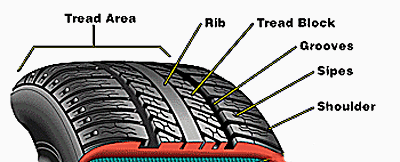As well as maximizing static friction, tires must minimize another kind of friction, called rolling resistance. Rolling resistance happens because tires are repeatedly squeezed underneath where the wheels press on them and stretched at the top when wheels release them.
All that stretching and squeezing wastes energy which could be used to go forward.
- Blocks in the middle of the tire form the tire's gripping surface or traction.
- Ribs, which are next to the blocks, also form the tire's gripping features consisting of straight-lined rows of blocks that create a circumferential contact "band".
- Sipes make the tire bend more to improve handling and consist of slit-like grooves in the tread blocks that allow the blocks to move with added flexibility, and increases traction by creating an additional biting edge.
Sipes are especially helpful on ice, light snow, and loose dirt.
- Shoulders add grip when the car is cornering.
They provide continuous contact with the road while maneuvering as they wrap slightly over the inner and outer sidewall of a tire.
- Grooves are the drains which the tire squeezes water along as it presses the road and pushes it out to the side.
A low void ratio groove means more rubber is in contact with the road while a high void ratio increases the ability to drain water.
Whether a tire has a high or low void ratio depends on the tire's intended use.
- Dimples are little depressions that are part of the shoulder.
Such indentations in the tread improve cooling.
- Belt, the reinforcement layer extending around the outer circumference of the carcass under the tread.
It acts like an iron hoop in improving the stiffness of the tread area. In the case of truck and bus tires, the belt is more heavily reinforced compared to passenger car tires.
- Tread is that part of a tire which contacts the road surface.
The tread consists of a layer of rubber, compounded to suit the application purpose of the tire, and the thickness serves to protect the belt and carcass.
The tread pattern functions to improve water drainage, providing traction, braking, and cornering characteristics; as well as, a longer tread life.
Different parts of tire tread work as a team to keep the car on the road.

